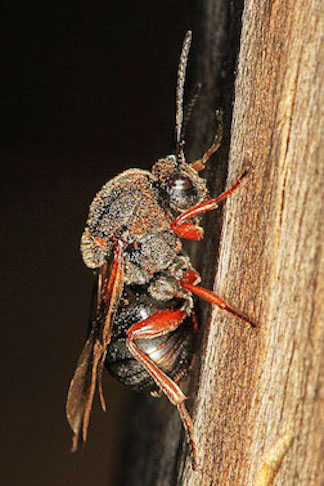Walking in Beauty
September 20, 2023
Oak galls part of natural ecosystem
Walking through Brennan Woods recently, I picked up a few fallen oak leaves, their undersides coated with white circular attachments.
These growths are called galls. Insects, usually wasps, lay their eggs in the leaf tissue and the galls form to protect the larvae as they emerge. The gall also provides a source of food for the insect. It develops and grows inside the gall and emerges as an adult during the summer or the following spring.
“There are several species of wasps that do this to oak leaves,” said Nate Simons, executive director of Blue Heron Ministries, which contracts with the Clear Lake Township Land Conservancy for various land management projects. “While the gall is not a disease, the leaves may drop early and a heavy infestation may defoliate the tree. The tree should be fine, even after a couple of years of this infestation.”
The galls on the fallen leaves at Brennan Woods look like white circles, though when magnified they resemble slices of dark brown acorns.
What we see on the leaves at Brennan Woods is just one of many known oak galls, the majority considered relatively harmless.
“Gall makers must attack at a particular time in the year to be successful. Otherwise, they may not be able to stimulate the plant to produce the tissue which forms the gall,” says a report by the University of Kentucky’s Martin-Gatton College of Agriculture, Food and Environment. “Generally, initiation of leaf galls occurs around ‘bud break’ or as new leaves begin to unfold in the spring.”
The galls protect the larvae from environmental threats and pesticides.
“Leaf galls rarely affect tree health so control is rarely justified,” says the UK website.
There are numerous varieties of galls that grow on oak trees, not all of them affecting the leaves. Purdue University Extension entomologists Clifford Sadof and Timothy Gibb note that galls – which can be created by a variety of living organisms in multiple types of plants – usually do not affect the health or vigor of the host plant.
“Your best management tool is patience,” says a report by Sadof and Gibb at extension.entm.purdue.edu. “Most galls will not kill a tree and tend to cycle through times when they are abundant and times when they are rare.”
There are around 800 species of gall wasps in North America, most of them very small.

This gall wasp, photographed at Leesylvania State Park in Woodbridge, Virginia, is one of around 800 species of gall wasps in North America. (Photo courtesy Wikipedia)
